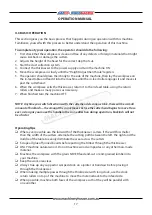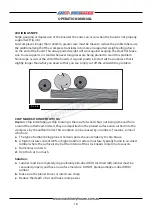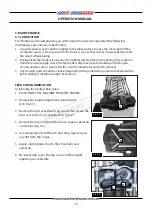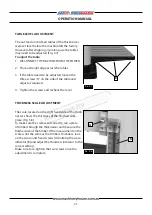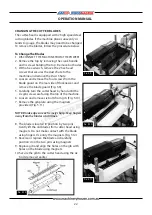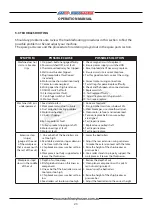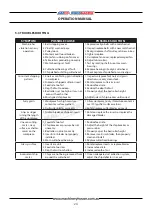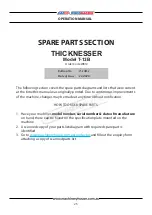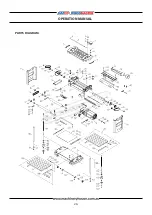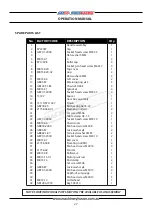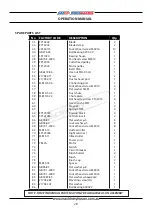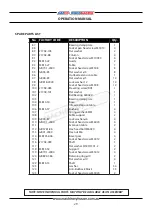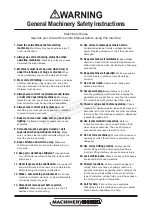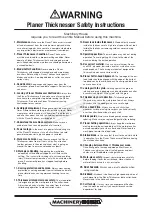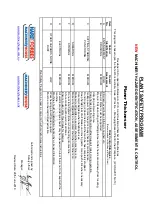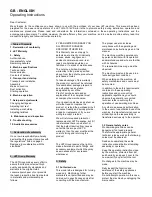
Planer Thicknesser Safety Instructions
1. Maintenance.
Make sure the Planer Thicknesser is turned
off and disconnect from the main power supply and make
sure all moving parts have come to a complete stop before
any inspection, adjustment or maintenance is carried out.
2. Planer Thicknesser Condition.
Planer Thicknesser
must be maintained for a proper working condition. Never
operate a Planer Thicknesser that has damaged or worn
parts. Scheduled routine maintenance should performed on
a scheduled basis.
3. Blade/Cutter Condition.
Never operate a Planer
Thicknesser with dropped, cracked or badly worn blades
or cutters. Before using a Planer Thicknesser inspect all
blades and cutters. A damaged blade or cutter can cause
serious injury.
4. Hand Hazard.
Keep hands and fingers clear from the
cutter-head, infeed & outfeed table supports. Serious injury
can occur.
5. Leaving a Planer Thicknesser Unattended.
Always turn
the Planer Thicknesser off and make sure all moving parts
have come to a complete stop before leaving the Planer
Thicknesser. Do not leave Planer Thicknesser running
unattended for any reason.
6. Avoiding Entanglement.
Blade guard must be used at all
times. Remove loose clothing, belts, or jewelry items. Never
wear gloves while machine is in operation. Tie up long hair
and use the correct hair nets to avoid any entanglement
with the Planer Thicknesser moving parts.
7. Understand the machines controls.
Make sure you
understand the use and operation of all controls.
8. Power outage.
In the event of a power failure during use
of the Planer Thicknesser, turn off all switches to avoid
possible sudden start up once power is restored.
9. Work area hazards.
Keep the area around the Planer
Thicknesser clean from oil, tools, chips. Pay attention
to other persons in the area and know what is going on
around the area to ensure unintended accidents.
10. Workpiece Handling.
Supporting the work-piece
adequately with additional supports at all times while
cutting. This is crucial for making safe cuts and avoiding
injury. Never attempt to make a cut with an unstable work-
piece. Ensure work piece has stopped feeding before
handling.
11. Hearing protection and hazards.
Always wear hearing
protection as noise generated from cutter-head and work-
piece vibration can cause permanent hearing loss over
time.
12. Thicknesser Infeed clearance safety.
The infeed roller
is designed to pull the work-piece into the cutter-head.
Always keep hands, clothing, hair away from the infeed
roller during operation to prevent serious injury.
13. Never look inside thicknesser.
Wood chips fly around
inside the thicknesser at a high rate of speed. Do not look
inside the thicknesser remove guards or covers during
operation.
14. Operating position.
The work-piece may kick out during
operation. To avoid getting hit, stand to the side of the
machine during the entire operation.
15. Use correct material.
Only use natural timber. Do not
use MDF, plywood, laminates, or other synthetic or man-
made products. Thicknessing material not designed for
this machine may cause serious injury.
16. Planer Cutter-head Alignment.
The top edge of the out-
feed table should be aligned with the edge of the knife at
top dead centre to avoid kickback. An unaligned table can
cause serious injury.
17. Joining with the grain.
Jointing against the grain or
jointing end grain is dangerous and could produce chatter
or excessive chip out. Always joint with the grain.
18. Thicknessing Grain direction.
Thicknessing across
the grain may cause the work-piece to kick out. Always
thickness with the wood grain or at a small angle.
19. Use a Push Stick.
Always use a push stick when
whenever surface planing. Never pass you hands directly
over the cutter-head without a push stick.
20. Blade guards.
Always use blade guards except when
rebating. Make sure you replace the guard after rebating.
21. Planer Cutting operation.
Always keep the work-piece
moving toward the outfeed table until the work-piece has
passed completely over the cutter-head. Never feed the
work-piece toward the infeed table.
22. Stalled blade.
In the case that the cutter-head stalls while
in operation, turn the Planer Thicknesser off before freeing
the stalled cutter-head.
23. Changing between Planer / Thicknesser mode.
Once changed to the required mode either Planer or
Thicknesser, always ensure all safety guards and dust
chutes are re-fitted before starting machine.
24. Work-piece safety.
Inspect your work-piece carefully
before feeding it over the cutter-head. Never thickness
material that has knots, nails, or staples.
25. Dust hazards.
Always use a dust collector when
using machine.
26. Kickback.
Kickback is defined as high speed expulsion of
work-piece from the Planer Thicknesser table cutter-head.
Never stand in the kickback zone.
27. Call for help.
If at any time you experience difficulties,
stop the machine and call you nearest branch service
department for help.
Machinery House
requires you to read this entire Manual before using this machine.

